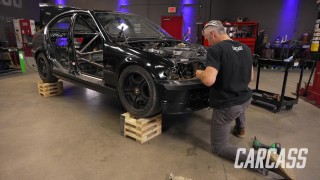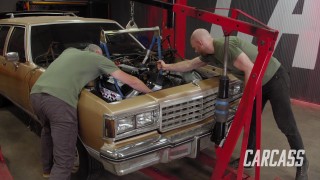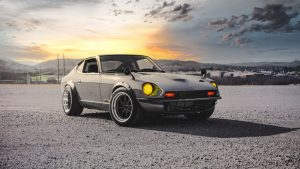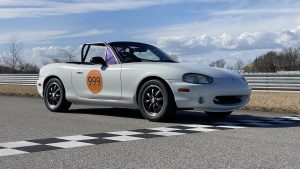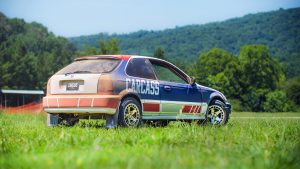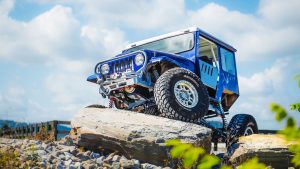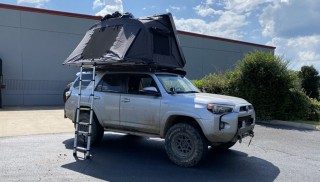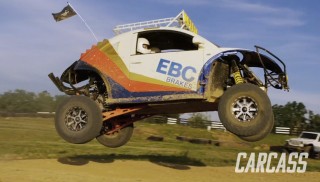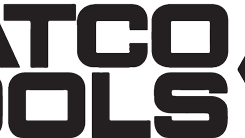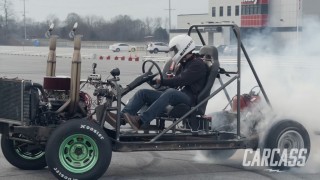Carcass Featured Projects
Carcass Builds
Want more content like this?
Join the PowerNation Email NewsletterParts Used In This Episode
Berryman Products
EZ Doz-It Penetrating Oil & Lubricant
NCM Motorsports Park
NCM Motorsports Park
The Industrial Depot
Tools, Hardware, Shop Supplies
Episode Transcript
(Jeremy)>> You're watching Powernation!
(Jeremy)>> Today on Carcass we head out to a high performance driving event that teaches anyone who's interested about going fast on a track.
(Jimmy)>> Then we start our own race car project. We hit the track and dyno to get some baseline numbers to see where we start. [ MUSIC ] [ tires squealing ] [ MUSIC ]
(Jimmy)>> Alright guys, welcome to the brand-new season of Carcass. I am in this bone stock Mazda Miata, and frankly a car that I don't fit into all that well but regardless of that Jeremy and I are gonna take this thing from its bone stock form and turn it into an absolute track weapon.
(Jeremy)>> And this is our little Honda Civic rally car that we built last season. Now this is kind of a real legitimate race car. It's fully caged. We've got some strut tower braces in here. We added a really nice set of coil over shocks, and at the time we put on some pretty beefy off road tiers, but we kinda set the car up a little bit differently. We lowered the stance to come out here, and we put on a decent set of street tires.
(Jimmy)>> So we're here at NCM Motorsports Park at an event put on by Auto Interests and Summit Racing, and what we're gonna do is learn how to be on a track safely and also learn how to drive.
(Jeremy)>> But it really doesn't matter. If you bring something as healthy as our little Honda Civic here, which is a true race car, or if you bring a car like our Mazda Miata that pretty much just came right off of the street. If you don't know how to drive either one of these cars it's really not gonna do you any good. So Jimmy, let's go learn how to drive.
(Jimmy)>> Let's do it. [ engine revving ]
(Jason)>> Auto Interests is a high-performance driving school program. Our main goal really was to get more people on track that had any kind of car that they wanted to do it with. Just decided that okay, we should really formalize more of the learning, and the curriculum. Really be more purposeful about how we credential instructors, and once you've been through our program you could go to nearly any high-performance driving program and use those skills. They're pretty universally applicable, and it kinda opens up a whole new world of something really cool to do with your car.
(Jimmy)>> But before you can take some laps on the track your car will have to go through tech inspection, but you don't have to worry about having a fully built race car. They have newcomers covered as well.
(Jason)>> For a first timer it's just a car in good mechanical condition. So fresh fluids, a decent set of brake pads, decent set of tires. It doesn't have to be some crazy build. So as long as it's in overall sound mechanical shape, as a first timer you're not gonna be going fast enough that you need a whole bunch of upgrades your very first time.
(Jeremy)>> After tech it's into the classroom for a little track driving 101.
(Rick)>> So we run basically three categories of people. We run a novice broken into novice-solo, which means you can go out on track by yourself without an instructor, and we run a first timer and that goes along with our acclimation program where we just want you to learn about the car, the track, and the etiquette. From there we'll teach everybody how to do the basics, but when you move up we'll move you to intermediate. The intermediate guys get a little less attention that's one on one but we're always available to give that attention. If you want help on something, if you're sticking on a corner, or something's wrong, you just can't quite get that flow we'll work with you. We'll jump in, we'll look at your data. We'll help you get faster because our real goal is to get you in the advanced class. Those guys might be some ex-racers. Maybe guys that have done h-p-d for a bunch of years. That's your real goal is to get that advanced class. So, my goal really is to make sure everybody's safe, make sure everybody has a good day, make sure the cars are safe, and then help everybody go as fast as they can.
(Jeremy)>> Grassroot programs like this are impossible without great partners.
(Jason)>> Summit Racing has been with us for several years now. They've been a huge supporter of the program. They've just been a great partner helping to market different events though channels they have. We really like that they connect directly in with our driving rewards program to reward drivers that drive well, and drive cleanly, that are safe, and it's just been a huge boon to the program. Really to help get a deeper engagement and that extra support behind it.
(Jimmy)>> Alright so we're in the car with chief instructor Rock Hoback. He's gonna teach us a few things. How to be safe on the track most importantly, and then also if he can give us any tips to try to get around the track faster. We also need some help in that department too. So let's see what we got.
(Rick)>> So my car's already warmed up, but you typically want to let your car warm up a little bit. Get the brakes nice and warm, get the tires nice and warm. You just kinda come in here a little bit and just get everything up to temp. You don't want to push too hard too early. So mentally you want to prepare, and you want to just kinda know your limits and what you're gonna do. So, this is where the course starts. This is turn one, two, and right here. So, we care about this apex but we don't care about what's after it. We don't care about this corner here. We want to come out and fade out, back on the gas, nice and smooth. This is kind of a diamond. What I do here is I kind of fade in, aim for the middle, turn sharp, let it rotate. Be patient, patient, back on the gas a little bit of rumble. Patience there is going to pay a lot of dividends. Cars really don't want to do multiple things at once. They don't want to accelerate and turn or brake and turn. If I tap the brake, like I'll do it here, and it'll want to tweak the rear end. So, if I go for the brake it doesn't really like that much, and it wants to rotate the rear around.
(Jimmy)>> So you just want to kinda accelerate and decelerate and turn separately.
(Rick)>> Very smooth! Your feet are really smooth. You don't want to jump on the gas, you don't want to jump on the brake. You just want to squeeze things. Sometimes it seems like you're ripping it, you're not. You're just squeezing. Some cars might carry a different line, a higher horsepower car. You know it might go a little farther from the edge of the course to the apex when he comes out or when he comes in. Little Miatas tend to run real tight lines. You'll never master, there's no perfect lap ever. You can always do something a little better, a little better. You don't need to bring your Corvette, your Porsche, your Mustang. You just need something simple that teaches you the basics and you go fast. There's the checkered flag. I don't know if you caught it out of the corner of your eye.
(Jimmy)>> Well thanks for having us, and I think we need to get on the track then right?
(Jeremy)>> Yeah, this is a lot of fun and I can't really wait to get out there and see what we can do.
(Jimmy)>> Up next, we hit the track to get some seat time and test out our new project.
(Jeremy)>> Hey guys, welcome back to Carcass. Now we're up here at NCM Motorsports Park. We're with the Auto Interests group. We just did our classroom time, and we did a couple of hot laps with Rick Hoback. Now it's time to hop in our cars.
(Jimmy)>> I'm gonna be in the Honda and you take the Miata. [ MUSIC ] [ engine revving ]
(Jimmy)>> I'm out here with our Honda Civic rally car and with a few suspension adjustments and new tires I'm trying to apply some of Rick's advice and have some fun. [ MUSIC ]
(Jeremy)>> If you guys haven't noticed by now, I'm in a 2000 Mazda Miata. Now the reason we bought this car is we had so much fun with our little Honda rally Civic and our o-b-s truck we thought, you know what, why not build another race car, and why not build a race car that's extremely popular? Now the difference between this car and our other two builds like the Honda and the truck, this is gonna be a spec Miata, and what that entails is when you go into a spec class as it be a Miata or something else it comes down to more or less the driver. Everybody's got the same resources, and you're limited to what you can do as far as upgrades go. So, you can only run specific tires. You can only run specific brakes. You're limited on engine upgrades and exhaust, and stuff like that. So, in a spec class it comes down to the person sitting in the driver's seat. So hench why we're here with Auto Interests Group and they're trying to teach us how to drive a little bit better. Once you're comfortable in your car then you get faster. The more you understand your car the faster you get. So, with our little Miata here we got a bunch of upgrades that we want to do within the rules of the spec Miata class and sticking with everybody else in the group we're gonna try to build ourselves a little race car, and not spin out. This little Miata's an absolute blast to drive, especially out here on a racetrack, in completely stock form. Yeah, it makes a couple of noises, like that. We've just got a tire rubbing, but the reality is a little four-cylinder five speed, this thing's like a rocket ship. This entire build we're gonna be doing with Summit Racing. They're really gonna help us out here to put this car together because we have to follow specific rules set in the spec class. Everything that we can get for this car we can get from Summit Racing. So, we are gonna put this little spec Miata together and have a whole bunch of fun with it.
(Jimmy)>> We had a tone of fun out here today at NCM Motorsports Park with the Auto Interests Group. We learned a lot, had some ride alongs, and I think we can be pretty safe on a track.
(Jeremy)>> And I got a really good baseline on how the Miata acts out there on the racetrack, but now it's time to take it back to the shop and turn this thing into a true race car.
(Jimmy)>> Yep, I got the Honda loaded up. I've got to strap it down still, but I'll meet you there.
(Jeremy)>> Yeah, I get to drive this one back. We now know how she handles on the track but how many horses does she pack?
(Pat)>> Holy moly!
(Jeremy)>> Hey guys, welcome back to Carcass. Well, we didn't waste any time. We've got our little Mazda Miata down here in Engine Power and it's strapped down to the chassis dyno. We also ran it around at NCM for a little bit, but right now we want to know how much horsepower this little four cylinder's gonna make.
(Jimmy)>> And in a spec Miata class there's not a whole lot we can do in terms of engine mods. So, we just wanted to get a base line to compare it to once we get everything done.
(Jeremy)>> So from here we'll get a couple of pulls, figure out some horsepower. We've got some things we're gonna do here coming up, and then we're gonna bring it right back and check to see if we gained any really.
(Pat)>> Did you bring the key to wind it up first cause I want to make full power with this thing.
(Jeremy)>> Yeah so it came with two sets of keys. So we used both of them and wound them up.
(Frankie)>> Are these the four cylinders that were missing out of your Honda? I know that only had four.
(Pat)>> We've got two cars here totaling eight cylinders at this point.
(Jeremy)>> Well we're looking to make half horsepower now and half horsepower later.
(Pat)>> In all seriousness these are kinda cool. These are a lot of fun for the money, they really are, and you have a spec Miata class obviously that's gonna be pretty fun to run in because it sounds like everything's pretty equal for what you can do to it and what you have to do to race.
(Jimmy)>> Yep, it really comes down to the driver and like a great way to increase your skills.
(Pat)>> What's it gonna make?
(Jimmy)>> 120!
(Jeremy)>> I'll go hondo.
(Pat)>> Okay 100, I'm gonna go 110.
(Frankie)>> 112, I'll split the difference.
(Pat)>> I think we're all pretty close. Alright, light this thing. [ engine starting ] [ engine revving ]
(Pat)>> It runs actually very nice. I know the first time I've ever been in a chassis dyno session with a Miata.
(Jeremy)>> Alright ready? Green button go! [ engine revving ]
(Pat)>> Oh wow!
(Jeremy)>> Alright, so I said 100.
(Frankie)>> What was your guess?
(Jimmy)>> 120.
(Frankie)>> Dang 121!
(Jeremy)>> Is that what it came up at? Dude I was 20 horse off.
(Pat)>> 121, 119-pound feet. I was way off too. Now we know right. Now you can time that pole with a sun dial.
(Frankie)>> 99 miles an hour.
(Pat)>> That's almost 100 miles an hour. You had a wheel speed of 99.59.
(Jeremy)>> This thing was an animal on the track. It did like 80 down the front.
(Pat)>> The pull is nice and smooth. There's no sign of anything going goofy. Back it up, make another one. So, one's a fluke.
(Jeremy)>> First gear, here we go.
(Pat)>> Yeah, he's getting a little aggressive now.
(Jeremy)>> Now I'm comfortable. Now I can go a little faster. Stab it! [ engine revving ]
(Pat)>> That'll probably print the same number.
(Jeremy)>> I revved it the exact same.
(Pat)>> Yep, 121 horse and this is within one-pound feet on torque.
(Jeremy)>> Well I'm thinking it's making 121 horsepower then.
(Pat)>> That's good!
(Frankie)>> Consistent too!
(Pat)>> What was your Honda?
(Jeremy)>> 89.
(Pat)>> See, just crushing that one. These are really neat little cars to be honest. They have a short wheelbase, they handle well, decent power. The power to weight ratio is pretty decent in these things.
(Jeremy)>> It was a blast to drive up at NCM, and again we've got to stick with that spec Miata stuff. So we can only do certain things to it. We're gonna take it back down, do those things right now, and if you guys are cool, we're gonna come right back after we're done and see what we gain for horsepower cause that's really all we can do.
(Jimmy)>> Squeeze everything we can out of it.
(Frankie)>> I'm interested to see what it's gonna make when you guys come back.
(Pat)>> Just easy stuff to it?
(Jeremy)>> Easy stuff, cold air intake.
(Jimmy)>> You can do some intake stuff, you can change the exhaust, and you can adjust the initial timing.
(Pat)>> And you guys have a way of doing that?
(Jeremy)>> We're gonna try to figure it out.
(Jimmy)>> Yeah, we'll figure everything out. I'm sure there's some tricks to this, and these guys that have done this for a long time they know everything.
(Pat)>> Okay, well you've got your work cut out for you. So get her done and get her back.
(Jeremy)>> We'll get her unstrapped, head down, we should be back in a couple of hours.
(Pat)>> Couple of hours alright.
(Jimmy)>> We add a few simple upgrades to get a boost in power!
(Jeremy)>> Alright guys, well we're back down in our shop with the little Miata here and we've got some base horsepower numbers, and now it's time to squeeze just a little more out of this thing. And one thing to note, that in the spec Miata rules there are a couple of different years you can run and a couple of different engine options. You can either have the 1.6 liter or the 1.8 liter, and we have the 1.8.
(Jimmy)>> The caveat to all of this is if you do run the bigger engine you have to run a restrictor plate. Now regardless of engine size it's really important to squeeze as much horsepower as you can just to give yourself the competitive edge, and so when we go back to the dyno we won't run the restrictor plate just to get an apples to apples comparison on horsepower.
(Jeremy)>> And per spec rules and the fact that we have the 1.8 liter we can only do a couple of things. So, we're gonna do a little bit of exhaust work. We're gonna bump the timing up just a little bit, and we can switch out the air filter. So, let's get this thing on the hoist and we'll start on the exhaust. Get this little shoebox up here. [ MUSIC ] [ mechanical humming ]
(Jimmy)>> Our exhaust system is pretty simple here. There's only a few things we can do, one of them being replacing the muffler in the back. We got one from Summit Racing that we'll install in a little bit. Otherwise, we can replace this whole section here, the catalytic converter, and this other tiny little muffler here with a straight section of pipe. The only thing to note here is if you still want to drive your car on the street not a good idea to take the cat out. We're gonna take it out, but this is a track only car. So, we don't have to worry about it. [ saw buzzing ] [ MUSIC ]
(Jeremy)>> Bee's next! [ MUSIC ] I got it.
(Jimmy)>> Before we start fitting up our new pipe, we'll grind the ends and clean them up. Alright so the rules say that the maximum tube diameter that you can use for this section is two and a quarter. We have all kinds of bits and pieces laying around the shop. So, this piece should work. We'll have to do some trimming, but one way or another we're gonna get it in there.
[ saw buzzing ]
(Jimmy)>> I've got this main pipe pretty well fitted. Something to note here is that on the back part of this exhaust this tube is closer to two inches. So, I have a little reducer here to put in it. I've just got to get Jeremy's help and I'll start tacking these pieces in. [ MUSIC ] [ welder crackling ] [ drill humming ]
(Jimmy)>> With our exhaust tacked in we'll take it out and head over to the welding table where we'll clean up the edges and finish welding it up. [ grinder buzzing ] [ welder crackling ]
(Jeremy)>> Alright with Jimmy welding up the exhaust now we can replace the stock muffler with this performance one that we got from Summit Racing. Pretty simple to install. We're just gonna slide the old one out and slide the new one in. We'll spray our exhaust hangers down with a little Berryman Products Easy Does It to help our muffler slide right out. There it goes. [ MUSIC ] This one just literally slides right into place. That simple! Now we can install our new exhaust and tighten it down. [ drill humming ]
(Jimmy)>> Alright, that wraps up the exhaust. Now we'll head to the front and adjust the timing.
(Jeremy)>> So the only way to adjust the timing per the spec rules is to do a little mod here to the crankshaft position sensor. I just have to pull this out. We elongate the mounting hole, put it right back in there, check our timing. [ MUSIC ] Alright to snake this out of here you might as well just do the mod to a new sensor and just replace this one anyways. So, the idea here is we're gonna file out the bottom side of the mounting hole. That's gonna allow our crank sensor to move up. What guys are doing is they're taking out about two and a half millimeters, or about 60 thousandths. That'll give us the advance that we're looking for. That should do it. Now we'll just put the new one back up and in here, throw a bolt in it, tighten it down, and then check our timing. Move that up. Then we'll just tighten it down, and then we'll go up top and check the timing.
(Jimmy)>> Ready?
(Jeremy)>> Yeah, pop the hood, I'll put the timing light on it, you hop in the car, crank it up, and we'll see where we're at with the timing. [ MUSIC ] Alright Jimmy, fire this thing up, check the timing quick. [ engine starting ]
(Jeremy)>> That's right around 14. So that should be good enough for now. I think the last thing we'll do is we'll throw the air filter in it, and then we'll just get it off the hoist and we'll run it down to Engine Power and see what it makes for power again. [ MUSIC ]
(Jimmy)>> Alright you guys ready?
(Frankie)>> Let's see how many bumble bees this thing picked up.
(Jeremy)>> Bumble bees, I like that actually.
(Frankie)>> That's what I think it sounds like.
(Pat)>> Definitely a different tone. [ engine revving ]
(Pat)>> I think he's trying to get it to 7,000.
(Jeremy)>> He likes seven grand. 125 horse!
(Frankie)>> 126.2 and 123.6 pound feet.
(Pat)>> We are literally celebrating that. Did you see how we all went woo!
(Jeremy)>> That's five horsepower!
(Frankie)>> You went 113 mile an hour.
(Jimmy)>> Well in a class that competitive that could make it you winning or you losing.
(Jeremy)>> I think for what we put into it and our five horsepower gain I think that's way worth it.
(Pat)>> Solid improvement!
(Frankie)>> For what you guys did that's easy horsepower.
(Jeremy)>> I think that pretty much wraps it up for us though. So, if you guys like anything you've seen on the show today why don't you go to Powernation TV dot com and the four of us are gonna unstrap this thing and Jimmy and I are gonna take it out of here. I think you're gonna help, aren't you?
(Pat)>> I'm gonna take this thing off right here.
Show Full Transcript
(Jeremy)>> Today on Carcass we head out to a high performance driving event that teaches anyone who's interested about going fast on a track.
(Jimmy)>> Then we start our own race car project. We hit the track and dyno to get some baseline numbers to see where we start. [ MUSIC ] [ tires squealing ] [ MUSIC ]
(Jimmy)>> Alright guys, welcome to the brand-new season of Carcass. I am in this bone stock Mazda Miata, and frankly a car that I don't fit into all that well but regardless of that Jeremy and I are gonna take this thing from its bone stock form and turn it into an absolute track weapon.
(Jeremy)>> And this is our little Honda Civic rally car that we built last season. Now this is kind of a real legitimate race car. It's fully caged. We've got some strut tower braces in here. We added a really nice set of coil over shocks, and at the time we put on some pretty beefy off road tiers, but we kinda set the car up a little bit differently. We lowered the stance to come out here, and we put on a decent set of street tires.
(Jimmy)>> So we're here at NCM Motorsports Park at an event put on by Auto Interests and Summit Racing, and what we're gonna do is learn how to be on a track safely and also learn how to drive.
(Jeremy)>> But it really doesn't matter. If you bring something as healthy as our little Honda Civic here, which is a true race car, or if you bring a car like our Mazda Miata that pretty much just came right off of the street. If you don't know how to drive either one of these cars it's really not gonna do you any good. So Jimmy, let's go learn how to drive.
(Jimmy)>> Let's do it. [ engine revving ]
(Jason)>> Auto Interests is a high-performance driving school program. Our main goal really was to get more people on track that had any kind of car that they wanted to do it with. Just decided that okay, we should really formalize more of the learning, and the curriculum. Really be more purposeful about how we credential instructors, and once you've been through our program you could go to nearly any high-performance driving program and use those skills. They're pretty universally applicable, and it kinda opens up a whole new world of something really cool to do with your car.
(Jimmy)>> But before you can take some laps on the track your car will have to go through tech inspection, but you don't have to worry about having a fully built race car. They have newcomers covered as well.
(Jason)>> For a first timer it's just a car in good mechanical condition. So fresh fluids, a decent set of brake pads, decent set of tires. It doesn't have to be some crazy build. So as long as it's in overall sound mechanical shape, as a first timer you're not gonna be going fast enough that you need a whole bunch of upgrades your very first time.
(Jeremy)>> After tech it's into the classroom for a little track driving 101.
(Rick)>> So we run basically three categories of people. We run a novice broken into novice-solo, which means you can go out on track by yourself without an instructor, and we run a first timer and that goes along with our acclimation program where we just want you to learn about the car, the track, and the etiquette. From there we'll teach everybody how to do the basics, but when you move up we'll move you to intermediate. The intermediate guys get a little less attention that's one on one but we're always available to give that attention. If you want help on something, if you're sticking on a corner, or something's wrong, you just can't quite get that flow we'll work with you. We'll jump in, we'll look at your data. We'll help you get faster because our real goal is to get you in the advanced class. Those guys might be some ex-racers. Maybe guys that have done h-p-d for a bunch of years. That's your real goal is to get that advanced class. So, my goal really is to make sure everybody's safe, make sure everybody has a good day, make sure the cars are safe, and then help everybody go as fast as they can.
(Jeremy)>> Grassroot programs like this are impossible without great partners.
(Jason)>> Summit Racing has been with us for several years now. They've been a huge supporter of the program. They've just been a great partner helping to market different events though channels they have. We really like that they connect directly in with our driving rewards program to reward drivers that drive well, and drive cleanly, that are safe, and it's just been a huge boon to the program. Really to help get a deeper engagement and that extra support behind it.
(Jimmy)>> Alright so we're in the car with chief instructor Rock Hoback. He's gonna teach us a few things. How to be safe on the track most importantly, and then also if he can give us any tips to try to get around the track faster. We also need some help in that department too. So let's see what we got.
(Rick)>> So my car's already warmed up, but you typically want to let your car warm up a little bit. Get the brakes nice and warm, get the tires nice and warm. You just kinda come in here a little bit and just get everything up to temp. You don't want to push too hard too early. So mentally you want to prepare, and you want to just kinda know your limits and what you're gonna do. So, this is where the course starts. This is turn one, two, and right here. So, we care about this apex but we don't care about what's after it. We don't care about this corner here. We want to come out and fade out, back on the gas, nice and smooth. This is kind of a diamond. What I do here is I kind of fade in, aim for the middle, turn sharp, let it rotate. Be patient, patient, back on the gas a little bit of rumble. Patience there is going to pay a lot of dividends. Cars really don't want to do multiple things at once. They don't want to accelerate and turn or brake and turn. If I tap the brake, like I'll do it here, and it'll want to tweak the rear end. So, if I go for the brake it doesn't really like that much, and it wants to rotate the rear around.
(Jimmy)>> So you just want to kinda accelerate and decelerate and turn separately.
(Rick)>> Very smooth! Your feet are really smooth. You don't want to jump on the gas, you don't want to jump on the brake. You just want to squeeze things. Sometimes it seems like you're ripping it, you're not. You're just squeezing. Some cars might carry a different line, a higher horsepower car. You know it might go a little farther from the edge of the course to the apex when he comes out or when he comes in. Little Miatas tend to run real tight lines. You'll never master, there's no perfect lap ever. You can always do something a little better, a little better. You don't need to bring your Corvette, your Porsche, your Mustang. You just need something simple that teaches you the basics and you go fast. There's the checkered flag. I don't know if you caught it out of the corner of your eye.
(Jimmy)>> Well thanks for having us, and I think we need to get on the track then right?
(Jeremy)>> Yeah, this is a lot of fun and I can't really wait to get out there and see what we can do.
(Jimmy)>> Up next, we hit the track to get some seat time and test out our new project.
(Jeremy)>> Hey guys, welcome back to Carcass. Now we're up here at NCM Motorsports Park. We're with the Auto Interests group. We just did our classroom time, and we did a couple of hot laps with Rick Hoback. Now it's time to hop in our cars.
(Jimmy)>> I'm gonna be in the Honda and you take the Miata. [ MUSIC ] [ engine revving ]
(Jimmy)>> I'm out here with our Honda Civic rally car and with a few suspension adjustments and new tires I'm trying to apply some of Rick's advice and have some fun. [ MUSIC ]
(Jeremy)>> If you guys haven't noticed by now, I'm in a 2000 Mazda Miata. Now the reason we bought this car is we had so much fun with our little Honda rally Civic and our o-b-s truck we thought, you know what, why not build another race car, and why not build a race car that's extremely popular? Now the difference between this car and our other two builds like the Honda and the truck, this is gonna be a spec Miata, and what that entails is when you go into a spec class as it be a Miata or something else it comes down to more or less the driver. Everybody's got the same resources, and you're limited to what you can do as far as upgrades go. So, you can only run specific tires. You can only run specific brakes. You're limited on engine upgrades and exhaust, and stuff like that. So, in a spec class it comes down to the person sitting in the driver's seat. So hench why we're here with Auto Interests Group and they're trying to teach us how to drive a little bit better. Once you're comfortable in your car then you get faster. The more you understand your car the faster you get. So, with our little Miata here we got a bunch of upgrades that we want to do within the rules of the spec Miata class and sticking with everybody else in the group we're gonna try to build ourselves a little race car, and not spin out. This little Miata's an absolute blast to drive, especially out here on a racetrack, in completely stock form. Yeah, it makes a couple of noises, like that. We've just got a tire rubbing, but the reality is a little four-cylinder five speed, this thing's like a rocket ship. This entire build we're gonna be doing with Summit Racing. They're really gonna help us out here to put this car together because we have to follow specific rules set in the spec class. Everything that we can get for this car we can get from Summit Racing. So, we are gonna put this little spec Miata together and have a whole bunch of fun with it.
(Jimmy)>> We had a tone of fun out here today at NCM Motorsports Park with the Auto Interests Group. We learned a lot, had some ride alongs, and I think we can be pretty safe on a track.
(Jeremy)>> And I got a really good baseline on how the Miata acts out there on the racetrack, but now it's time to take it back to the shop and turn this thing into a true race car.
(Jimmy)>> Yep, I got the Honda loaded up. I've got to strap it down still, but I'll meet you there.
(Jeremy)>> Yeah, I get to drive this one back. We now know how she handles on the track but how many horses does she pack?
(Pat)>> Holy moly!
(Jeremy)>> Hey guys, welcome back to Carcass. Well, we didn't waste any time. We've got our little Mazda Miata down here in Engine Power and it's strapped down to the chassis dyno. We also ran it around at NCM for a little bit, but right now we want to know how much horsepower this little four cylinder's gonna make.
(Jimmy)>> And in a spec Miata class there's not a whole lot we can do in terms of engine mods. So, we just wanted to get a base line to compare it to once we get everything done.
(Jeremy)>> So from here we'll get a couple of pulls, figure out some horsepower. We've got some things we're gonna do here coming up, and then we're gonna bring it right back and check to see if we gained any really.
(Pat)>> Did you bring the key to wind it up first cause I want to make full power with this thing.
(Jeremy)>> Yeah so it came with two sets of keys. So we used both of them and wound them up.
(Frankie)>> Are these the four cylinders that were missing out of your Honda? I know that only had four.
(Pat)>> We've got two cars here totaling eight cylinders at this point.
(Jeremy)>> Well we're looking to make half horsepower now and half horsepower later.
(Pat)>> In all seriousness these are kinda cool. These are a lot of fun for the money, they really are, and you have a spec Miata class obviously that's gonna be pretty fun to run in because it sounds like everything's pretty equal for what you can do to it and what you have to do to race.
(Jimmy)>> Yep, it really comes down to the driver and like a great way to increase your skills.
(Pat)>> What's it gonna make?
(Jimmy)>> 120!
(Jeremy)>> I'll go hondo.
(Pat)>> Okay 100, I'm gonna go 110.
(Frankie)>> 112, I'll split the difference.
(Pat)>> I think we're all pretty close. Alright, light this thing. [ engine starting ] [ engine revving ]
(Pat)>> It runs actually very nice. I know the first time I've ever been in a chassis dyno session with a Miata.
(Jeremy)>> Alright ready? Green button go! [ engine revving ]
(Pat)>> Oh wow!
(Jeremy)>> Alright, so I said 100.
(Frankie)>> What was your guess?
(Jimmy)>> 120.
(Frankie)>> Dang 121!
(Jeremy)>> Is that what it came up at? Dude I was 20 horse off.
(Pat)>> 121, 119-pound feet. I was way off too. Now we know right. Now you can time that pole with a sun dial.
(Frankie)>> 99 miles an hour.
(Pat)>> That's almost 100 miles an hour. You had a wheel speed of 99.59.
(Jeremy)>> This thing was an animal on the track. It did like 80 down the front.
(Pat)>> The pull is nice and smooth. There's no sign of anything going goofy. Back it up, make another one. So, one's a fluke.
(Jeremy)>> First gear, here we go.
(Pat)>> Yeah, he's getting a little aggressive now.
(Jeremy)>> Now I'm comfortable. Now I can go a little faster. Stab it! [ engine revving ]
(Pat)>> That'll probably print the same number.
(Jeremy)>> I revved it the exact same.
(Pat)>> Yep, 121 horse and this is within one-pound feet on torque.
(Jeremy)>> Well I'm thinking it's making 121 horsepower then.
(Pat)>> That's good!
(Frankie)>> Consistent too!
(Pat)>> What was your Honda?
(Jeremy)>> 89.
(Pat)>> See, just crushing that one. These are really neat little cars to be honest. They have a short wheelbase, they handle well, decent power. The power to weight ratio is pretty decent in these things.
(Jeremy)>> It was a blast to drive up at NCM, and again we've got to stick with that spec Miata stuff. So we can only do certain things to it. We're gonna take it back down, do those things right now, and if you guys are cool, we're gonna come right back after we're done and see what we gain for horsepower cause that's really all we can do.
(Jimmy)>> Squeeze everything we can out of it.
(Frankie)>> I'm interested to see what it's gonna make when you guys come back.
(Pat)>> Just easy stuff to it?
(Jeremy)>> Easy stuff, cold air intake.
(Jimmy)>> You can do some intake stuff, you can change the exhaust, and you can adjust the initial timing.
(Pat)>> And you guys have a way of doing that?
(Jeremy)>> We're gonna try to figure it out.
(Jimmy)>> Yeah, we'll figure everything out. I'm sure there's some tricks to this, and these guys that have done this for a long time they know everything.
(Pat)>> Okay, well you've got your work cut out for you. So get her done and get her back.
(Jeremy)>> We'll get her unstrapped, head down, we should be back in a couple of hours.
(Pat)>> Couple of hours alright.
(Jimmy)>> We add a few simple upgrades to get a boost in power!
(Jeremy)>> Alright guys, well we're back down in our shop with the little Miata here and we've got some base horsepower numbers, and now it's time to squeeze just a little more out of this thing. And one thing to note, that in the spec Miata rules there are a couple of different years you can run and a couple of different engine options. You can either have the 1.6 liter or the 1.8 liter, and we have the 1.8.
(Jimmy)>> The caveat to all of this is if you do run the bigger engine you have to run a restrictor plate. Now regardless of engine size it's really important to squeeze as much horsepower as you can just to give yourself the competitive edge, and so when we go back to the dyno we won't run the restrictor plate just to get an apples to apples comparison on horsepower.
(Jeremy)>> And per spec rules and the fact that we have the 1.8 liter we can only do a couple of things. So, we're gonna do a little bit of exhaust work. We're gonna bump the timing up just a little bit, and we can switch out the air filter. So, let's get this thing on the hoist and we'll start on the exhaust. Get this little shoebox up here. [ MUSIC ] [ mechanical humming ]
(Jimmy)>> Our exhaust system is pretty simple here. There's only a few things we can do, one of them being replacing the muffler in the back. We got one from Summit Racing that we'll install in a little bit. Otherwise, we can replace this whole section here, the catalytic converter, and this other tiny little muffler here with a straight section of pipe. The only thing to note here is if you still want to drive your car on the street not a good idea to take the cat out. We're gonna take it out, but this is a track only car. So, we don't have to worry about it. [ saw buzzing ] [ MUSIC ]
(Jeremy)>> Bee's next! [ MUSIC ] I got it.
(Jimmy)>> Before we start fitting up our new pipe, we'll grind the ends and clean them up. Alright so the rules say that the maximum tube diameter that you can use for this section is two and a quarter. We have all kinds of bits and pieces laying around the shop. So, this piece should work. We'll have to do some trimming, but one way or another we're gonna get it in there.
[ saw buzzing ]
(Jimmy)>> I've got this main pipe pretty well fitted. Something to note here is that on the back part of this exhaust this tube is closer to two inches. So, I have a little reducer here to put in it. I've just got to get Jeremy's help and I'll start tacking these pieces in. [ MUSIC ] [ welder crackling ] [ drill humming ]
(Jimmy)>> With our exhaust tacked in we'll take it out and head over to the welding table where we'll clean up the edges and finish welding it up. [ grinder buzzing ] [ welder crackling ]
(Jeremy)>> Alright with Jimmy welding up the exhaust now we can replace the stock muffler with this performance one that we got from Summit Racing. Pretty simple to install. We're just gonna slide the old one out and slide the new one in. We'll spray our exhaust hangers down with a little Berryman Products Easy Does It to help our muffler slide right out. There it goes. [ MUSIC ] This one just literally slides right into place. That simple! Now we can install our new exhaust and tighten it down. [ drill humming ]
(Jimmy)>> Alright, that wraps up the exhaust. Now we'll head to the front and adjust the timing.
(Jeremy)>> So the only way to adjust the timing per the spec rules is to do a little mod here to the crankshaft position sensor. I just have to pull this out. We elongate the mounting hole, put it right back in there, check our timing. [ MUSIC ] Alright to snake this out of here you might as well just do the mod to a new sensor and just replace this one anyways. So, the idea here is we're gonna file out the bottom side of the mounting hole. That's gonna allow our crank sensor to move up. What guys are doing is they're taking out about two and a half millimeters, or about 60 thousandths. That'll give us the advance that we're looking for. That should do it. Now we'll just put the new one back up and in here, throw a bolt in it, tighten it down, and then check our timing. Move that up. Then we'll just tighten it down, and then we'll go up top and check the timing.
(Jimmy)>> Ready?
(Jeremy)>> Yeah, pop the hood, I'll put the timing light on it, you hop in the car, crank it up, and we'll see where we're at with the timing. [ MUSIC ] Alright Jimmy, fire this thing up, check the timing quick. [ engine starting ]
(Jeremy)>> That's right around 14. So that should be good enough for now. I think the last thing we'll do is we'll throw the air filter in it, and then we'll just get it off the hoist and we'll run it down to Engine Power and see what it makes for power again. [ MUSIC ]
(Jimmy)>> Alright you guys ready?
(Frankie)>> Let's see how many bumble bees this thing picked up.
(Jeremy)>> Bumble bees, I like that actually.
(Frankie)>> That's what I think it sounds like.
(Pat)>> Definitely a different tone. [ engine revving ]
(Pat)>> I think he's trying to get it to 7,000.
(Jeremy)>> He likes seven grand. 125 horse!
(Frankie)>> 126.2 and 123.6 pound feet.
(Pat)>> We are literally celebrating that. Did you see how we all went woo!
(Jeremy)>> That's five horsepower!
(Frankie)>> You went 113 mile an hour.
(Jimmy)>> Well in a class that competitive that could make it you winning or you losing.
(Jeremy)>> I think for what we put into it and our five horsepower gain I think that's way worth it.
(Pat)>> Solid improvement!
(Frankie)>> For what you guys did that's easy horsepower.
(Jeremy)>> I think that pretty much wraps it up for us though. So, if you guys like anything you've seen on the show today why don't you go to Powernation TV dot com and the four of us are gonna unstrap this thing and Jimmy and I are gonna take it out of here. I think you're gonna help, aren't you?
(Pat)>> I'm gonna take this thing off right here.







